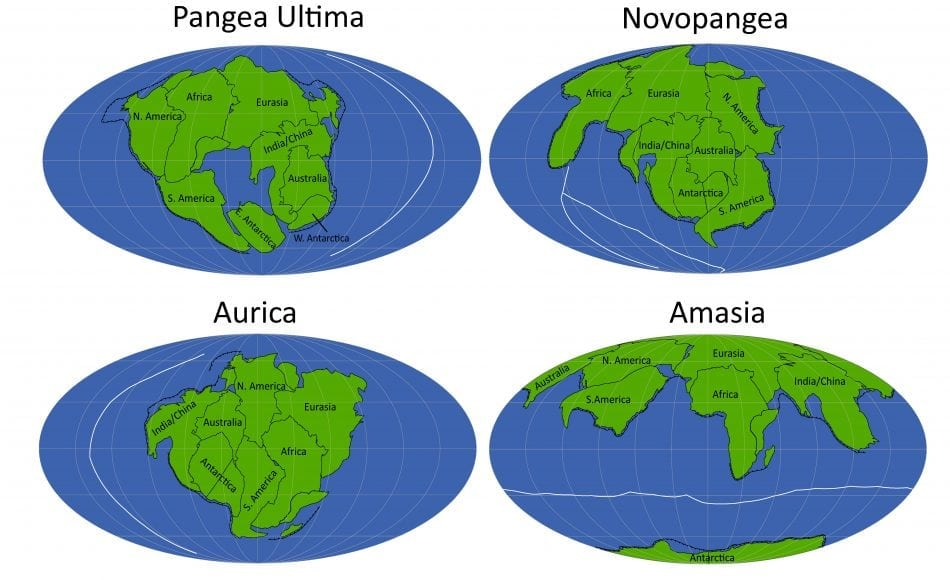
Predicting the Future
How can we even guess what might happen in the far future? This falls under the field of speculative evolution, a fusion of science and art. Speculative evolution applies known rules of biology and a generous serving of imagination to hypothesize possible paths evolution can take in hypothetical scenarios. Speculative evolution can be applied to the far future, alternate histories, or alien planets. These speculations are by their nature a creative endeavor, but they are informed by what science tells us about how the planet and the life upon it work.
What Can We Know?
What do we know about the future of the Earth? A few events beyond 10,000 years can be predicted with a reasonable degree of certainty. Geology can predict the movement of the continents, trends from the past can be extrapolated to the future, and theoretical physics can predict the potential fate of the universe.
Plate Tectonics
Certain trends in the drift of the earth’s continents can be predicted in the short term. Each continental plate is currently moving, as they have been for billions of years. Although far too short to notice in a lifetime, over millions of years these movements add up. Paleogeographer Christopher Scotese has worked to reconstruct the movements of the continents throughout earth’s history, and he has also extrapolated these trends to predict contintental drift up to 250 million years in the future. If current continental drift trends continue, then in the short term Africa and Australia will move north as the Atlantic Ocean continues to widen, forming mountain ranges with Eurasia. California will be dragged north by the rotation of the Pacific Plate, and the East African Rift Valley will widen, splitting the continent of Africa in two.

Every 500 million years or so, the continents will collide into a supercontinent. Eventually, the supercontinent will break up as tectonic plates continue to move, but the continents will eventually form again. The latest supercontinent in the earth's history was Pangaea, which formed around 300 million years ago and started to break up 200 million years ago. Extrapolating this into the future, it is predicted that a supercontinent will form in about 200-250 million years. There are four competing models for the configuration of this supercontinent: Pangaea Ultima, Novopangaea, Aurica, and Amasia. Scotese's Pangaea Ultima1 configuration postulates that the Atlantic Ocean will eventually close after the Mid-Atlantic Ridge subducts, causing the Americas to collide with the western edge of Afro-Eurasia. The Novopangaea2 configuration, proposed by Paul Hoffman, posulates that the Atlantic will continue to widen and the Pacific Ocean will instead close, causing the Americas to collide with eastern Asia and Australia. The Amasia configuration of Mitchell et al. 2012 posulates that the Arctic Ocean will close, bringing the Americas and Afro-Eurasia together over the north pole. The Aurica configuration, first postulated and tested by Davies et al., postulates that both the Atlantic and Pacific oceans will close, and a new ocean basin will open up and separate Eurasia. Any of these configurations are possible, though one recent study suggests that the Novopangaea model may be the most likely.
Here, we use Scotese's model as a baseline for future continental drift. The Atlantic Ocean will continue to widen, pushing continents apart, until roughly 100 million years ahead. It will then close again, bringing the continents into a supercontinent. We chose Pangaea Ultima as our supercontinent, although our configuration is slightly different than Scotese's. Beyond the initial formation, our continental drift model is entirely hypothetical. We also incorporated other future geological predictions, such as the formation of new Hawaiian islands, where relevant, and the plan for 500 million years and further follows scientific predictions for the ultimate fate of the earth.
- Scotese and others prefer to use the term "Pangaea Proxima" now, as the term "Pangaea Ultima" implies, without justification, that there will be no further supercontinents after it. We opt to continue using "Pangaea Ultima" because it sounds cooler.
- The television show The Future is Wild follows this configuration, calling it "Pangaea II".
Climate
The history of the earth shows that climate generally follows the movement of the continents. Ice ages, or icehouse worlds, tend to occur when the continents prevent warm water from reaching the poles, or when high mountain ranges form as continents collide. These mountain ranges encourage the weathering of atmospheric carbon dioxide, which reduces. These icehouse periods intersperse longer warm periods, also known as greenhouse worlds, which lack permanent polar ice caps. As the continents are unlikely to change much in the near future, the earth will remain in its current icehouse climate. Once Antarctica moves away from the south pole, however, the planet will likely warm once again. Our predictions for global temperatures are heavily influenced by the predicted movement of the continents; the warm, wet post-Antarctica climate will give into a hot, dry climate with the formation of Pangaea Ultima. Little moisture would be able to reach the interior of the supercontinent, leading to harsh, arid conditions globally. The next major icehouse world will occur when Pangaea Ultima covers the North Pole, promoting the formation of an ice cap. This follows the predictions of Way et al., 2021, which modeled the climate of possible future supercontinents.
Extrapolating Evolution
Although aspects of the future of the planet can be predicted or hypothesized, the paths that life will take is impossible to tell for certain. This is where the speculation comes in. We can look at the patterns of past and current evolution and extrapolate these into the future.
Evolution is a process of change over time, in which populations adapt to better survive and reproduce in response to the environment. Evolution can produce a myriad of solutions to common problems; for example, eyes have evolved many times in animals, and no two types of eye are alike. This leads to a staggering degree of diversity. The process of evolution is a topic far too complex to summarize here; we recommend Understanding Evolution as a crash course in evolution.
It is without doubt that the process of evolution will continue into the future. Certain evolutionary trends we can see through prehistory and the modern day may also be extrapolated to occur in the future. Some of these biological "rules" include Bergmann's and Allen's rules, which predict animals in colder climates will have larger bodies and shorter extremities respectively. Application of these rules can help provide a framework for our pathway of the future.

To take one example, terrestrial island owls had evolved multiple times in prehistory. It is relatively easy for flighted birds to arrive on islands devoid of megafauna. Owls are adaptable predators, and although they bear many specializations for hunting in the air, they can and will hunt on the ground if given the opportunity (a lifestyle capitalized upon by the extant burrowing owl). Four times, large-bodied terrestrially-foraging owls have evolved on islands: the giant Cuban owl (Ornimegalonyx), the Cretan owl (Athene cretensis), the stilt-owls of Hawaii (Grallistrix), and the flightless barn owl Tyto pollens of the Bahamas. We took this trend and carried it over to the future, resulting in Eustolas, the great terrestrial owl of future Hawaii. After the disappearance of humans, we predict that barn owls will island-hop along the Hawaiian archipelago, following the path that the ancestors of the extinct stilt-owls took. With no large predators surviving the wake of humanity, they will quickly take over. Inspired by Ornimegalonyx, we also applied Foster's rule, also known as the "island effect": our future owls have grown in size, over a meter in height.
Every so often, there are events that lead to many lineages going extinct. These are known as mass extinctions. There are considered to be five major mass extinction events and 15 minor ones in the past 542 million years. The causes for these extinction events include mass volcanism, asteroid impacts, and rapid climatic changes. The mass extinctions of this project are staggered similarly; after the one the earth has recently begun to go through, there will be five major extinction events and several minor events through the next 500 million years. The species best equipped to survive these extinctions are usually generalized, adaptable, and quick to reproduce. It is these species that will proliferate first after the disappearance of humans.
Naturally, the exact course of what will happen is entirely unknown. This is where speculation takes over. A creative license is necessary to fill in the framework of evolution, to provide a rich bestiary of the future. The exact evolutionary story we have come up with here is very unlikely to actually occur, as we will never know the paths evolution will take in the millions of years to come. But it is possible nevertheless.